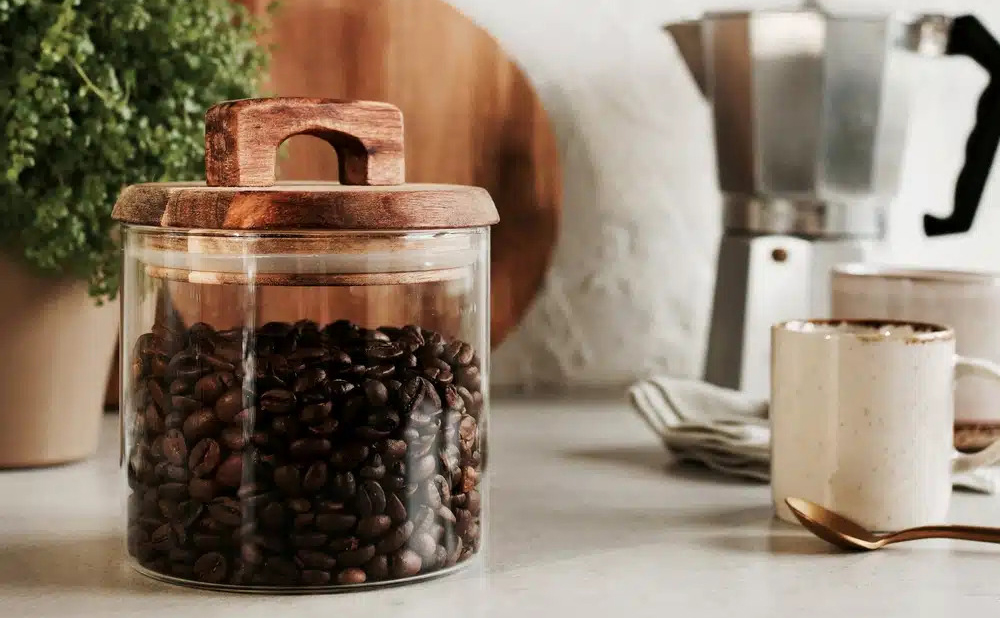We often receive questions about the best coffee storage methods and how to keep coffee fresh for as long as possible.
Many sources suggest that coffee must be stored in a vacuum canister, but our view is that room-temperature storage works perfectly fine in most cases.
It’s true that after about six months, coffee can start to taste oxidized — so as long as you prevent oxidation, you’ll be fine.
The two things to watch out for are dark-roasted beans, which oxidize more easily, and the hot, humid summer season, when coffee deteriorates faster.
In this article, we’ll explain what to keep in mind when storing your coffee and share our recommended coffee storage methods.
Follow these tips to keep your beans fresh and flavorful — and enjoy every cup down to the last!
Three Factors That Make Coffee Taste Bad

There are three main culprits that oxidize coffee and ruin its flavor: light, oxygen, and heat & humidity.
- Direct sunlight causes the aroma to fade and increases bitterness.
- Exposure to oxygen removes sweetness and acidity while producing a stale, oxidized smell.
- High temperature and humidity speed up oxidation and introduce unwanted moisture, which leads to off-flavors.
The secret to maintaining great-tasting coffee is simple: reduce these three factors as much as possible.
Recommended Coffee Storage Methods

Now, let’s look at how to prevent your coffee from oxidizing and losing its flavor.
The ideal storage method depends on how quickly you plan to finish your beans, so check the option that best fits your routine.
Room-Temperature Storage in the Original Bag (Within 1 Month)
If you plan to finish your coffee within about a month after opening, keeping it at room temperature in its original bag is perfectly fine.
Most roasters use packaging made from light-blocking and moisture-resistant materials.
At Waikiki Coffee, for instance, we use aluminum-laminated bags that completely block light and air, keeping the beans in excellent condition.
In fact, this type of bag is better than transferring coffee into canisters, zip bags, or plastic containers.
Many roasters also include one-way valves that allow air to escape but prevent oxygen from entering, or they flush the bag with nitrogen to extend freshness.
As long as the bag remains sealed, room-temperature storage works perfectly.
If you’ll finish the coffee within a month, simply close the bag tightly with a clip after each use — no need for vacuum sealing.
Refrigerated Storage in an Aluminum Can (Up to 2 Months)
An even better option than room-temperature storage is to place the coffee bag inside an aluminum can and store it in the refrigerator.
The aluminum can helps prevent condensation and odor absorption from other foods.
With this method, the oxidation rate drops to less than half of that at room temperature, helping your coffee maintain its aroma, sweetness, and clarity for up to two months.
However, be careful — frequent opening and closing can cause temperature changes, which may lead to condensation and faster oxidation.
Depending on your storage conditions, this could become a disadvantage.
Freezing in Small Portions (Over 2 Months)
If it will take longer to finish your beans, freezing is the best storage method.
Coffee begins to oxidize about two to three weeks after opening, so if you’ll need more than two months to drink it all, freezing is highly recommended.
Freezing essentially stops oxidation, keeping your beans in great condition for a long time.
Just make sure to divide them into small portions, seal them tightly, and protect them from condensation to preserve maximum freshness.
And one common question — “Should I grind frozen beans or wait until they thaw?”
You can grind them while still frozen — no problem at all!

